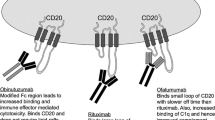Abstract
Alemtuzumab (Campath-1H) is a monoclonal antibody (MAb) that shows its most powerful effects in clearing malignant CD52-bearing cells from the blood and bone marrow. Attention had therefore focused on the use of alemtuzumab in the treatment of B-cell chronic lymphocytic leukemia (B-CLL), in which symptoms are the result of an expansion of a CD1a+/CD5+/CD23+/CD52+ malignant clone, causing lymphocytosis in the circulation and pervasive infiltration of the bone marrow. In clinical trials, in heavily pretreated patients, alemtuzumab was effective, producing responses in about one-third of patients who had failed to respond previously to chemotherapy, including fludarabine. In addition, there was an even higher clinical effect in the bone marrow. Alemtuzumab treatment has also allowed patients with advanced disease to proceed to stem cell transplantation, and preliminary data indicate that alemtuzumab is highly effective in previously untreated patients with B-CLL.
Similar content being viewed by others
References
Montserrat, E. (2001). Developing risk-adapted strategies for chronic lymphocytic leukemia. In: Chronic Lymphoid Leukemias (B.D. Cheson, ed.), Vol. 1, pp. 377–391, Marcel Dekker, New York.
Johnson, S., et al. (1996). Multicentre prospective randomised trial of fludarabine versus cyclophosphamide, doxorubicin, and prednisone (CAP) for treatment of advanced-stage chronic lymphocytic leukaemia. The French Cooperative Group on CLL [see comments]. Lancet 347(9013):1432–1438.
Rai, K.R., et al. (2000). Fludarabine compared with chlorambucil as primary therapy for chronic lymphocytic leukemia. N. Engl. J. Med. 343(24):1750–1757.
Riechmann, L., Clark, M., Waldmann, H. and Winter, G. (1988). Reshaping human antibodies for therapy. Nature 332(6162):323–327.
Rossmann, E.D., et al. (2001). Variability in B-cell antigen expression: implications for the treatment of B-cell lymphomas and leukemias with monoclonal antibodies. Hematol. J. 2:300–306.
Ginaldi, L., et al. (1998). Levels of expression of CD52 in normal and leukemic B and T cells: correlation with in vivo therapeutic responses to Campath-1H. Leuk. Res. 22(2):185–191.
Hale, G. (2001). The CD52 antigen and development of the Campath antibodies. Cytotherapy 3(3):137–143.
Rowan, W., Tite, J., Topley, P. and Brett, S.J. (1998). Cross-linking of the CAMPATH-1 antigen (CD52) mediates growth inhibition in human B- and T-lymphoma cell lines, and subsequent emergence of CD52-deficient cells. Immunology 95(3):427–436.
Rai, K.R. and Stephenson, J. (2001). Monoclonal antibodies in cancer: the development of Campath-1H. In: Campath-1H: Emerging Frontline Therapy in Chronic Lymphocytic Leukemia. Parthenon Publishing Group, Lancaster, UK.
Dyer, M.S.J., Hale, G., Marcus, R. and Waldmann, H. (1990). Remission induction in patients with lymphoid malignancies using unconjugated Campath-1H monoclonal antibodies. Leuk. Lymphoma 2:179–193.
Dyer, M.J., Hale, G., Hayhoe, F.G. and Waldmann, H. (1989). Effects of CAMPATH-1 antibodies in vivo in patients with lymphoid malignancies: influence of antibody isotype. Blood 73(6):1431–1439.
Rawstron, A.C., et al. (1997). Campath-1H therapy for patients with refractory chronic lymphocytic leukemia (CLL). Blood 90(Suppl. 1):529a.
Osterborg, A., et al. (1997). Phase II multicenter study of human CD52 antibody in previously treated chronic lymphocytic leukemia. European Study Group of CAMPATH-1H Treatment in Chronic Lymphocytic Leukemia. J. Clin. Oncol. 15(4):1567–1574.
Bowen, A.L., et al. (1997). Subcutaneous CAMPATH-1H in fludarabine-resistant/relapsed chronic lymphocytic and B-prolymphocytic leukaemia. Br. J. Haematol. 96(3):617–619.
Ferrajoli, A., et al. (2000). Phase II clinical trial of Campath-1H in refractory hematological malignancies expressing the surface antigen CD52. Proc. Am. Soc. Clin. Oncol. 19:8a.
Hoffman, M., Jansen, D. and Rai, K. (1999). Analysis of response to Campath-1H in patients with B-CLL progressing after fludarabine therapy. Hematol. Cell Ther. IWCLL 67, abstract P129.
Rai, K. (2000). Campath-1H is an effective salvage therapy for fludarabine-failing B-CLL patients. Blood 96:abstract 703.
Pangalis, G.A., Dimopoulou, M.N., Angelopoulou, M.K. and Siakantaris, M.P. (2000). Campath-1H in B-chronic lymphocytic leukemia: report on a patient treated thrice in a 3 year period. Med. Oncol. 17:70–73.
Keating, M.J., et al. (2002). Therapeutic role of alemtuzumab (Campath-1H) in patients who have failed fludarabine: results of a large international study. Blood, in press.
Cheson, B.D., et al. (1996). National Cancer Institute-sponsored Working Group guidelines for chronic lymphocytic leukemia: revised guidelines for diagnosis and treatment. Blood 87(12):4990–4997.
Keating, M., et al. (2002). Results of first salvage therapy for patients refractory to a Fludara regimen in chronic lymphocytic leukemia. Leuk. Lymphoma, in press.
Flynn, J.M. and Byrd, J.C. (2001). Campath-1H monoclonal antibody therapy. Curr. Opin. Oncol. 12(6):574–581.
Keating, M.J., et al. (1999). Multicenter study of Campath-1H in patients with chronic lymphocytic leukemia (B-CLL) refractory to fludarabine. Blood 94:abstract 3118.
Osterborg, A., et al. (1996). Humanized CD52 monoclonal antibody Campath-1H as first-line treatment in chronic lymphocytic leukaemia. Br. J. Haematol. 93(1):151–153.
Lundin, J., et al. (2000). CAMPATH-1H therapy of patients with previously untreated chronic lymphocytic leukemia (CLL). Ann. Oncol. 11(Suppl. 4):96.
Schey, S.A., Ahsan G., and Jones, R. (1999). Dose intensification and molecular responses in patients with chronic lymphocytic leukemia: a phase ll single center study. Bone Marrow Transplant. 24:989–993.
Visani, G., et al. (1999). Fludarabine-containing regimens severely impair peripheral blood stem cells mobilization and collection in acute myeloid leukaemia patients. Br. J. Haematol. 105(3):775–779.
Dyer, M.J., et al. (1997). In vivo “purging” of residual disease in CLL with Campath-1H. Br. J. Haematol. 97(3):669–672.
Kennedy, S., et al. (1999). Campath-1H therapy in 29 patients with refractory CLL: “true” complete remission is an attainable goal. Blood 94(10, Suppl. 1):603a.
Kennedy, B., et al. (2000). Campath-1H with fludarabine: a novel, highly active combination in refractory CLL. Blood 96:abstract 4991.
Author information
Authors and Affiliations
Corresponding author
Rights and permissions
About this article
Cite this article
Osterborg, A., Mellstedt, H. & Keating, M. Clinical effects of alemtuzumab (Campath-1H) in B-cell chronic lymphocytic leukemia. Med Oncol 19 (Suppl 2), S21–S26 (2002). https://doi.org/10.1385/MO:19:2S:S21
Issue Date:
DOI: https://doi.org/10.1385/MO:19:2S:S21




